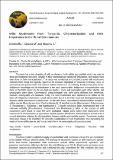| dc.description.abstract | Tanzania has a rich diversity of wild mushrooms, both edible and inedible which are used as
food and medicinal resources. Despite of their nutritional and medicinal importance, few studies have
been done on their characterization. This study was carried out to characterize some wild mushrooms
collected from Iringa and Njombe regions in the Southern Highlands of Tanzania in January, 2014. A
semi-structured questionnaire was used to collect information on edibility, local (vernacular) names,
indigenous knowledge and its importance to the rural communities. Indigenous characterization was
done in the field, based on the key features (colour, shape and association with other plants), and
photographs were taken. Conventional characterization was done using different key references,
manuals, monographs and databases. Only five wild mushrooms were reported to be edible on the
basis of indigenous information. Local names were found to be very important distinguishing factor
between edible and poisonous mushrooms. On the other hand, conventional characterization revealed 7
edible species (Russulaceae-4 and Cantharelaceae-3), 11 inedible species (Boletaceae-4, Polyporaceae 3, Russulaceae-2, Suillaceae-1 and Agaricaceae-1), 2 deadly poisonous (both Amanitaceae) and 4 of
unknown edibility (Russulaceae-2, Suillaceae-1 and Boletaceae-1). Most of the species of wild
mushrooms were found to share the same ecological habitat. Only edible wild mushrooms were
reported to be of importance as opposed to inedible species. Mushroom characterization proved to be a
crucial distinctive criterion for distinguishing between edible and inedible species. Taxonomic studies
have been shown to be important for accurate classification of wild mushrooms, thus preventing the
waste of some edible species and human deaths from the consumption of poisonous ones. | en_US |

